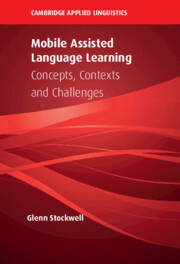Book contents
- Mobile Assisted Language Learning
- The Cambridge Applied Linguistics Series
- Mobile Assisted Language Learning
- Copyright page
- Dedication
- Contents
- Figures
- Tables
- Acknowledgements
- Abbreviations
- 1 Introduction
- 2 Fundamental Considerations of Teaching with Mobile Technologies
- 3 Shifting Paradigms in Language Learning and Teaching
- 4 Research Considerations in MALL
- 5 Theory in MALL
- 6 Physical, Psychosocial and Pedagogical Issues
- 7 The Learner in MALL
- 8 Designing MALL Environments
- 9 Concepts, Contexts and Challenges in MALL
- Glossary
- References
- Index
6 - Physical, Psychosocial and Pedagogical Issues
Published online by Cambridge University Press: 23 December 2021
- Mobile Assisted Language Learning
- The Cambridge Applied Linguistics Series
- Mobile Assisted Language Learning
- Copyright page
- Dedication
- Contents
- Figures
- Tables
- Acknowledgements
- Abbreviations
- 1 Introduction
- 2 Fundamental Considerations of Teaching with Mobile Technologies
- 3 Shifting Paradigms in Language Learning and Teaching
- 4 Research Considerations in MALL
- 5 Theory in MALL
- 6 Physical, Psychosocial and Pedagogical Issues
- 7 The Learner in MALL
- 8 Designing MALL Environments
- 9 Concepts, Contexts and Challenges in MALL
- Glossary
- References
- Index
Summary
This chapter explores the physical, psychosocial and pedagogical issues associated with MALL. The physical characteristics of mobile devices such as the size of the screen and the input methods have long been an issue when considering their applicability for learning, but these have often been considered as necessary trade-offs in order to maintainmobile devices' portability. In addition to this, however, there are also psychosocial issues, considering the position of mobile devices in the minds of the learners and teachers, such as a personal tool for private uses or a tool that can be applied to any use as required. This perception of mobile devices is often a product of the social context in which they are used, and this will likely vary depending on the region, the socioeconomic status and the age group of the users. Furthermore, the dangers in distractions both inside and outside of the device are described here along the psychological impact of mobile devices on learners’ abilities to concentrate on multiple tasks. Finally, the issue of pedagogy when learning through mobile devices and the factors that may be thought to contribute to successfully achieving learning goals and sustaining task engagement are discussed.
- Type
- Chapter
- Information
- Mobile Assisted Language LearningConcepts, Contexts and Challenges, pp. 114 - 129Publisher: Cambridge University PressPrint publication year: 2022

